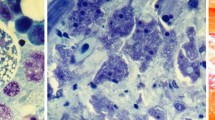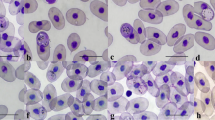Abstract
During a recent study of red-backed salamanders (Plethodon cinereus), we discovered an intraerythrocytic organism typified by violet-staining, intracellular inclusions, consistent with descriptions of Cytamoeba or Aegyptianella (bacteria). Here we characterize its taxonomic status using molecular techniques and ask basic questions about its nature. Blood smears from 102 salamanders were examined from Pennsylvania, New York, and Virginia to determine prevalence, and whole blood from several infected animals was tested using a PCR which targets the 16S rRNA gene of bacteria. Phylogenetic analysis of partial 16S rRNA gene sequence (1201 bp) indicated this organism was in the order Rickettsiales and is likely a member of the family Anaplasmatacea. The organism differed from currently described taxa and was clearly differentiated from Aegyptianella pullorum of birds and “Candidatus Hemobacterium ranarum” (formally A. ranarum) of frogs. Of all salamanders, 17 (16.7%) were infected and these were significantly larger (snout–vent length) and had higher body condition scores than uninfected ones, and males were more likely to be infected than females. Erythrocytes affected by the pathogen were 5% larger than unaffected ones, but otherwise similar in morphology. Infected animals tended to have a greater number of circulating white blood cells, based on estimates from smears, indicating a nonspecific response to the pathogen by the innate immune system. Given its phylogenetic position, this pathogen is likely transmitted by an arthropod vector, and the male-biased prevalence strongly implicates trombiculid mites, which also live in leaf litter and affect male salamanders more so than females.






Similar content being viewed by others
References
Anthony CD, Mendelson JR, Simons RR (1994) Differential parasitism by sex on plethodontid salamanders and histological evidence for structural damage to the nasolabial groove. American Midland Naturalist 132:302–307.
Babudieri B (1972) Mycoplasma-like organism, parasite of red blood cells of an amphibian, Hydromantes italicus (Spelerpes fuscus). Infection and Immunity 6:77–82.
Barta JR, Desser SS (1984) Blood parasites of amphibians from Algonquin Park, Ontario. Journal of Wildlife Diseases 20:180–189.
Brown JD, Keel MK, Yabsley MJ, Thigpen T, Maerz JC (2006) Clinical challenge. Journal of Zoo and Wildlife Medicine 37:571–573.
Brumpt E, Lavier C (1935) Sur un piroplasmide nouveau parasite de Tortue, Tunetella emydis n. g. n. sp. Annales de Parasitologie Humaine et Comparee (Paris) 13:544–550.
Chutmongkonkul M, Khonsue W, Pariyanonth P (2006) Blood parasites of six species of wild amphibians from Khun Mae Kuang forest area, Thailand. Proceedings from the 2nd Symposium on Asian Zoo and Wildlife Medicine and the 1st Workshop on Zoo and Wildlife Pathology: 48
Daszak P, Berger L, Cunningham AA, Hyatt AD, Green DE, Speare R (1999) Emerging infectious diseases and amphibian population declines. Emerging Infectious Diseases 5:735–748.
Davis AK (2008) Ontogenetic changes in erythrocyte morphology in larval mole salamanders, Ambystoma talpoideum, measured with image analysis. Comparative Clinical Pathology 17:23–28.
Davis AK, Holcomb KL (2008) Intraerythrocytic inclusion bodies in painted turtles (Chrysemys picta picta) with measurements of affected cells. Comparative Clinical Pathology 17:51–54.
Davis AK, Maerz JC (2008a) Comparison of hematological stress indicators in recently captured and captive paedomorphic mole salamanders, Ambystoma talpoideum. Copeia 2008:613–617.
Davis AK, Maerz JC (2008b) Sex-related differences in hematological stress indices of breeding, paedomorphic mole salamanders. Journal of Herpetology 42:197–201.
Davis AK, Yabsley MJ, Keel K, Maerz JC (2007) Discovery of a novel alveolate pathogen affecting southern leopard frogs in Georgia: description of the disease and host effects. EcoHealth 4:310–317.
Davis AK, Milanovich JR, DeVore JL, Maerz JC (2009) An investigation of factors influencing erythrocyte morphology of red-backed salamanders. Animal Biology 59:201–209
Desser SS (1987) Aegyptianella ranarum sp. n. (Rickettsiales, Anaplasmataceae): ultrastructure and prevalence in frogs from Ontario. Journal of Wildlife Diseases 23:52–59.
Desser SS, Barta JR (1989) The morphological features of Aegyptianella bacterifera: an intraerythrocytic rickettsia of frogs from Corsica. Journal of Wildlife Diseases 25:313–318.
Feder ME (1983) Integrating the ecology and physiology of plethodontid salamanders. Herpetologica 39:291–310.
Forson D, Storfer A (2006) Atrazine increases ranavirus susceptibility in the tiger salamander, Ambystoma tigrinum. Ecological Applications 16:2325–2332.
Gothe R, Kreier JD (1978) Aegyptianella, Eperythrozoon and Haemobartonella. In: Parasitic Protozoa, Vol. 4, Kreier JD (editor), San Diego, CA: Academic Press, pp. 251–294
Hamilton KS, Standaert SM, Kinney MC (2004) Characteristic peripheral blood findings in human ehrlichiosis. Modern Pathology 17:512–517
Hegner RW (1921) Cytamoeba bacterifera in the red blood cells of the frog. Journal of Parasitology 7:157–161
Jain NC (1986) Schalm’s Veterinary Hematology, Philadelphia: Lea & Febiger
Kocan A, Levesque GC, Whitworth LC, Murphy GL, Ewing SA, Barker RW (2000) Naturally occurring Ehrlichia chaffeensis infection in coyotes from Oklahoma. Emerging Infectious Diseases 6:477–480
Kumar S, Tamura K, Nei M (2004) MEGA3: integrated software for molecular evolutionary genetics analysis and sequence alignment. Briefings in Bioinformatics 5:150–163
Labbé A (1894) Recherches zoologiques et biologiques sur les parasites endoglobulaires du sang des vertébrés. Archives de Zoologie Experimentale et Generale 3:1–258
Lehmann DL (1961) Cytamoeba bacterifera Labbe, 1894. I. Morphology and host incidence of the parasite in California. Journal of Protozoology 8:29–33.
Lehmann DL (1964) Cytological and cytochemical studies on Cytamoeba bacterifera Labbé, 1894. Parasitology 54:121–124.
McAllister CT, Upton SJ, Trauth SE (1993) Endoparasites of western slimy salamanders, Plethodon albagula (Caudata, Plethodontidae), from Arkansas. Journal of the Helminthological Society of Washington 60:124–126.
McAllister CT, Bursey CR, Upton SJ, Trauth SE, Conn DB (1995) Parasites of Desmognathus brimleyorum (Caudata, Plethodontidae) from the Ouachita mountains of Arkansas and Oklahoma. Journal of the Helminthological Society of Washington 62:150–156.
Muths E, Corn PS, Pessier AP, Green DE (2003) Evidence for disease-related amphibian decline in Colorado. Biological Conservation 110:357–365.
Nazifi S, Razavi SM, Yavari F, Rajaifar M, Bazyar E, Esmailnejad Z (2008) Evaluation of hematological values in indigenous chickens infected with Plasmodium gallinaceum and Aegyptianella pullorum. Comparative Clinical Pathology 17:145–148.
Paddock CD, Yabsley MJ (2007) Ecological havoc, the rise of white-tailed deer, and the emergence of Amblyomma americanum-associated zoonoses in the United States. In: Wildlife and Emerging Zoonotic Diseases: The Biology, Circumstances and Consequences of Cross-Species Transmission, MacKenzie JS, Childs JE, Richt JA (editors), Berlin: Springer-Verlag Berlin, pp 289–324
Persing DH (1996) PCR Protocols for Emerging Infectious Diseases. A Supplement to Diagnostic Molecular Microbiology: Principles and Applications, Washington, DC: ASM Press.
Rankin JS (1937) An ecological study of parasites of some North Carolina salamanders. Ecological Monographs 7:169–269.
Rikihisa Y (2006) New findings on members of the family Anaplasmataceae of veterinary importance. Annals of the New York Academy of Sciences 1078:438–445.
Rikihisa Y, Zhang C, Christensen BM (2003) Molecular characterization of Aegyptianella pullorum (Rickettsiales, Anaplasmataceae). Journal of Clinical Microbiology 41:5294–5297.
Sassera D, Beninati T, Bandi C, Bouman EAP, Sacchi L, Fabbi M, et al. (2006) ‘Candidatus Midichloria mitochondrii,’ an endosymbiont of the tick Ixodes ricinus with a unique intramitochondrial lifestyle. International Journal of Systematic and Evolutionary Microbiology 56:2535–2540.
Statistica (2003) Statistica version 6.1, Tulsa, OK: Statsoft Inc.
Stenberg PL, Bowerman WJ (2008) Hemoparasites in Oregon spotted frogs (Rana pretiosa) from central Oregon, USA. Journal of Wildlife Diseases 44:464–468
Thompson JD, Higgins DG, Giboson TJ, Clustal W (1994) Improving and sensitivity of progressive multiple sequence alignment through sequence weighting, position-specific gap penalties and weight matrix choice. Nucleic Acids Research 22:4673–4680
Todd BD, Davis AK (2007) Sexual dichromatism in the marbled salamander, Ambystoma opacum. Canadian Journal of Zoology 85:1008–1013
Villolobos M, Leo P, Sessions SK, Kezer J (1988) Enucleated erythrocytes in plethodontid salamanders. Herpetologica 44:243–250
Werner JK (1993) Blood parasites of amphibians from Sichuan Province, Peoples Republic of China. Journal of Parasitology 79:356–363
Westfall MC, Cecala KK, Price SJ, Dorcas ME (2008) Patterns of trombiculid mite (Hannemania dunni) parasitism among plethodontid salamanders in the western Piedmont of North Carolina. Journal of Parasitology 94:631–634.
Zhang C, Rikihisa Y (2004) Proposal to transfer ‘Aegyptianella ranarum,’ an intracellular bacterium of frog red blood cells, to the family Flavobacteriaceae as ‘Candidatus Hemobacterium ranarum’ comb. nov. Environmental Microbiology 6:568–573.
Acknowledgments
Sonia Altizer provided blood samples from Virginia salamanders and provided helpful discussions on the project. AKD was supported by the D.B. Warnell School of Forestry and Natural Resources during this project. Tissues were collected from salamanders collected and sacrificed for a separate project covered under IACUC AUP#A2006-10041, and supported by NSF-DEB DEB0542974 to JCM.
Author information
Authors and Affiliations
Corresponding author
Rights and permissions
About this article
Cite this article
Davis, A.K., DeVore, J.L., Milanovich, J.R. et al. New Findings from an Old Pathogen: Intraerythrocytic Bacteria (Family Anaplasmatacea) in Red-Backed Salamanders Plethodon cinereus . EcoHealth 6, 219–228 (2009). https://doi.org/10.1007/s10393-009-0250-0
Received:
Revised:
Accepted:
Published:
Issue Date:
DOI: https://doi.org/10.1007/s10393-009-0250-0




